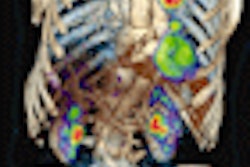
With apologies to Shakespeare, concern over the business model advanced by Imaging Advantage, the California firm that employs a hybrid model of staffing radiology departments nationwide directly through employed radiologists and indirectly though teleradiology, is much ado about the same old thing: competition.
 |
| Healthcare business and legal affairs expert Mark F. Weiss. |
Radiology groups need to take simple steps in defense of their business -- steps that are effective whether competition is from another traditional radiology group in the local area, a national staffing model entity, or a hybrid entity, as Imaging Advantage describes itself.
Before discussing those steps, let's examine the nature of competition and what traditional groups have done to invite it.
What is capitalism?
The economist Joseph Schumpeter wrote in Capitalism, Socialism and Democracy that capitalism "is by nature a form or method of economic change and not only never is but never can be stationary. And this evolutionary character ... incessantly revolutionizes the economic structure from within, incessantly destroying the old one, incessantly creating a new one. This process of Creative Destruction is the essential fact about capitalism."
It's foolish to think that the present radiology business model will never change. That's not to say with any certainty that national staffing or the hybrid staffing/teleradiology model will crowd out the local-based practice model. In fact, each of the national staffing and hybrid models is evolutionary, not revolutionary. In a sense, they are no different from the national staffing model that exists in some segments of the anesthesia market and in areas in and outside of healthcare in which telecommuting and outsourcing are common.
“There's nothing more or less to fear from competition from national and hybrid provider groups than there is from other local groups.”
This type of commercial evolution, and especially the borrowing of concepts from other industries, is timeless. Henry Ford "invented" production line automobile manufacturing by adopting the production line methods of the Chicago slaughterhouses.
New models often come into play in exploiting weaknesses in existing models, and this is clearly the case with respect to the toehold being gained by both the national staffing and hybrid models.
In many cases, local radiology groups have created this weakness by abdicating participation in medical staff activities, through assigning a second-class importance to the personal interaction between radiologists and patients, and especially to the personal interaction between radiologists and referring physicians. There's been an impact, too, from the less-than-fully-thought-out use of teleradiology.
But the message of this article isn't that there's no hope. First, radiology isn't the auto industry, and, as we know all too well, even if it were, simply mass producing cars doesn't mean they will sell. Second, both national staffing and hybrid models come packed with potential faults that can easily be exploited. Third, and most important, the methods radiology groups use to combat the potential for competition from other traditional groups (whether you are dealing with this threat now is another issue) are the same methods which must be used in competing against newer delivery models.
Start with telling the truth
The first step, perhaps the hardest of them all, is for you to tell yourself the truth about where your group presently is in terms of its relationships: the relationship among the group's owner members; the relationship between the group and its employed/subcontracted physicians; the relationship between the group's physicians and the medical staff; the relationship between the group and hospital administration; and the relationship between the group and "influencers," members of the community, whether medical staff, hospital, or the community at large, who influence the decision to contract with or retain the relationship between the hospital and your group.
Each of those relationships is a battleground in the war for the minds of those communities. If you lie to yourself about how wonderful the relationship is between your group and the referring physicians, you'll be caught completely off guard when your contract is terminated, "Group X" -- local, national, traditional, or hybrid -- is brought in to staff the department, and the referring physicians don't utter even a peep on your behalf.
Set strategy to achieve your goals
You can't position your group to compete if it does not know where it is going. A common problem among all hospital-based groups is that they tend to focus simply on serving the daily needs of the hospital -- otherwise, they just "are." They are too busy working in their practice to work on their business. They never engage in strategic thinking on the larger group level (where is it that the group wants to be X years in the future?), the specific substrategy level (what's our strategy in respect of relationships with referring physicians?), or the tactical level (how does doing such and such relate to our strategy?).
Create an experience monopoly
When developing specific substrategies, it's essential that your group generate its plan for creating a monopoly in terms of the experience that it provides to those with which it deals. I refer to this as a Unique Hospital/Referral Source/Patient Experience, and you can learn more about it in Part 4 of this series, "Creating an 'experience monopoly.' "
The creation of such a monopoly is key in fighting off would-be as well as actual competitors. Although both national staffing and hybrid delivery models offer certain advantages to hospital administrators, they come with a particular set of baggage -- carpet baggage.
Returning for a moment to the car analogy, these national organizations offer a production line model, a Chevy so to speak. Your goal is to create a Ferrari experience --- and even then, one custom-tailored to your medical staff, your referral sources, your hospital's administration, and your patients. If you must "benchmark," a notion that I generally find silly because it means to follow, not to lead, then benchmark to Ferrari, the Ritz-Carlton, and the Four Seasons, for they are the leaders in the experience economy.
Understand the connectivity
It's a mistake to believe, or to not give any thought at all to, the fact that relationships and dealings in organizing and operating a radiology group are discrete events. Quite the contrary, almost all of these instances are related.
For example, the organizational structure of a group determines whether a strong enough leadership can enforce the implementation and execution of strategy, and the provisions of the group's compensation plan impact on how owner and employed/subcontracted physicians will interact with patients and referral sources.
Conclusion
There's nothing more or less to fear from competition from national and hybrid provider groups than there is from other local groups. Both traditional providers and "evolved" models come with potential advantages and potential disadvantages. In all cases, the preparation work in which your group must always be engaged in, with respect to potential competition as well as in defense of your practice from other encroachment, involves taking advantage of the connectivity of business functions to greatly increase the chances that the group will meet its strategic goals. Those goals must include becoming the only logical choice for imaging services at the facilities you serve, to the exclusion of all other groups, whether local, national, or hybrid.
By Mark F. Weiss
AuntMinnie.com contributing writer
August 18, 2009
Mark F. Weiss is an attorney who specializes in the business and legal issues affecting radiology and other physician groups. He holds an appointment as clinical assistant professor of anesthesiology at University of Southern California's Keck School of Medicine and practices nationally with the Advisory Law Group, a firm with offices in Los Angeles and Santa Barbara, CA. Mr. Weiss provides complimentary educational materials to our readers. Visit www.advisorylawgroup.com for his free newsletter. He can be reached by e-mail at [email protected].
Related Reading
The Profit Center: Part 5 -- Negotiating your group's stipend, July 31, 2009
The Profit Center: Part 4 -- Creating an 'experience monopoly,' July 3, 2009
Readying for the Red Flags Rule: It pays to be prepared, May 26, 2009
The Profit Center: Part 3 -- Crafting effective employment contracts, April 24, 2009
The Profit Center: Part 2 -- Steering clear of Stark and false-claims violations, March 31, 2009
Copyright © 2009 Mark F. Weiss



















